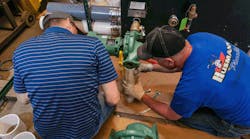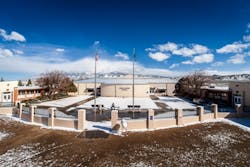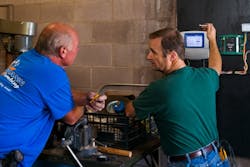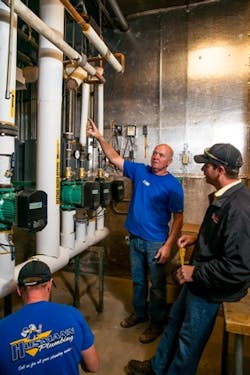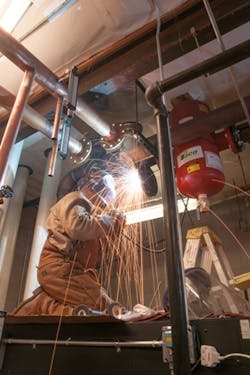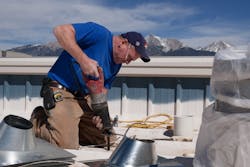FORT GARLAND, COLO. — Sierra Grande K-12 school in Fort Garland, Colo., struggled to make it through the mild 2011-2012 winter. Of the three 1.8 million Btuh LP-fired, cast iron boilers in the mechanical room, one had been down for some time. Another caught on fire halfway through the heating season.
The third boiler managed to heat the building until the school’s spring break in March. The boilers were providing water at 160°F to a variety of fan coil units and a small quantity of fin-tube baseboard. A long-outdated pneumatic control system made individual classroom controllability a distant dream.
After years of consideration and several bids, the school board decided that a new system was past due. The 80,000-sq.ft., 42-classroom school would have its new system in the blink of an eye.
“We’ve got six days to remove and replace 4.8 million Btu worth of boiler capacity,” said Matt Husmann, president of Husmann Plumbing & Heating, Alamosa, Colo., on March 15, the day before the project began. “Fan coil units make up most of the system and, fortunately, that equipment is still in good shape.”
Although the design phase for the project started in mid-2010, both Husmann and school administrators wanted the retrofit to take place over spring break so the energy savings could begin right away. Late April marks the tail end of the heating season in Southern Colorado, and after waiting more than a year to acquire funding for the project, the school district was out of patience. They wanted to see the savings begin as soon as possible.
Husmann’s 12-technician crew was ready for the task, but it was no small undertaking. The 26-year-old boilers needed to go.
“One of my kids attends Sierra Grande,” said Husmann several weeks before the job began. “I’ve worked with the school and Merryman [Mike Merryman is with McCoy Sales in Littleton, Colo.] on this design for a year and a half, and helped the board seek funding to get it done. We’re going to knock it out of the park. I think we’ll easily see a 50% energy savings, but I’m hoping for 65%.” In 2010, the school used 28,600 gallons of propane.
Along with his brother, Mike, and sister Monica, Matt took over the family business in 2006. Their parents started the firm in 1975, after relocating from Missouri. Today, the company is as much a supplier as a contractor.
“After working with Matt for months on the plan for the school, I was confident that Husmann could do the job well within a week’s time,” said Superintendent of Sierra Grande Darren Edgar.
The breakdown
The three old boilers would come out and six, 800 Mbh Burnham Commercial Apex modulating condensing boilers were to be installed. The new boilers, stacked two high, would use a third of the space required by the original propane-guzzling system.
“The new boilers have a 5:1turndown so — altogether — we’ll have a 30:1 turndown,” explained Husmann. “Tied to an outdoor reset, the system will modulate precisely with the crazy temperature swings we have in this valley.”
“The old pneumatic controls have been a real problem for the school, so we’re using Taco’s new iWorx control system to bring the building into the next century,” said Mike Merryman with McCoy Sales in Littleton, Colo., the manufacturer’s rep firm for Taco and Burnham. “We designed a piping strategy that can keep up with the new controls and boilers.”
The high pressure drop associated with the commercial modulating condensing boilers requires a high-head pump. Husmann is using six Taco 1900 series pumps to move water through each boiler and into a short primary boiler loop. Two big, closely spaced tees act as a hydraulic separator, tying the boiler loop into the existing 5-in. steel secondary loop.
Six zones branch off the big secondary loop, each pressurized by one of Taco’s new ECM, variable-speed Viridian pumps. The pumps were chosen mainly for their ability to ramp up and down, perfectly matching the needed flow rate regardless of how many classrooms call for heat.
Anywhere between four and 10 classrooms are tied into each secondary loop. Given the variation in the number of terminal units, the zone piping ranges between 1½-in. to 3-in. in diameter.
At each classroom, a ¾-in. line tees off to supply a fan coil unit or short baseboard run. Although the existing fan coil units were left in place, each now has a Taco Zone Sentry valve controlled by iWorx, in place of the old pneumatic zone valves. At the time, the pneumatic controls remained in place, to be replaced during summer break.
Quick off the blocks: Friday, March 16
“I’m on my way to the jobsite now,” said Merryman. “Husmann is already there, pulling the old boilers out.” Merryman’s commute is a little more than three hours, while the Husmann shop is about 30 minutes from Sierra Grande.
“I’ll be staying in Fort Garland a few nights next week,” continued Merryman. “With as much buildup to this as we’ve had, I’m not missing the action.” When he arrived, he saw that the boilers were literally being pulled out. Through a set of double doors in the mechanical room, Husmann’s crew was using a chain and a skid-loader to drag the boilers out of the building.
While three techs worked at removing the old boilers, three more unpacked the new units and got them ready for installation. Apex boilers, from the factory, run on natural gas. Burnham did a special build for the Sierra Grande project because only propane was available to the school.
Once inside, the boilers were stacked two-high on the concrete boiler pad. Plenty of space was left between stacks for ease of servicing and maintenance in the future.
Monday, March 19
“The challenge on Monday was staying out of each others’ way,” said Mike Husmann, Matt’s older brother, who was onsite for the duration of the project. “There was a welder, two electricians, Merryman, myself and another technician there the whole day.”
The welder worked to prepare the existing 5-in. steel secondary loop for connection to the new boilers and pumps. The big pipe runs the whole way around the building, and with the use of six 15-HP Viridian pumps, six zones deliver heat to the fan coil units.
Meanwhile, the Husmann crew went flat out on the boiler loop. The primary loop starts with 2-in. copper at the first stack of two boilers, jumps to 3-in. as it reaches the second stack, and when it passes the third stack, the copper is 4-in. in diameter.
Next to the boilers, two stainless steel coil, 119-gal. indirect water heaters now handle the school’s domestic load. The near-boiler piping was almost complete Monday; the only thing that remained was tying into the steel loop. Electricians wired the boilers quickly, knowing that the time to fire the boilers would come in the next few days.
Tuesday, March 20
With the end clearly in sight, the 6-in. supply and exhaust vent PVC was installed on Tuesday. With six boilers in such close proximity, the venting looks like a white and gray PVC forest as it reaches up to exit through the roof.
The 5-in. steel pipe required a welder to install two closely-spaced tees to tie into the 4-in. copper loop to complete the primary-secondary system. The copper and steel met at noon on the third day. Before leaving, the welder installed a 5-in. Taco 4900 series air and dirt separator.
Wednesday, March 21
First thing on Wednesday morning, Mike and his apprentice, Jerry Houser, ran gas lines to the new boilers; the very last component to the extensive, break-neck speed installation. Like all the other facets of the project, the gas lines went in without any trouble.
While the boilers lit their maiden fire, Husmann and Houser cleaned up the mechanical room and ran relief valves.
“We wrapped the job up on Wednesday,” said Matt Husmann. “The boilers were fired for the first time, two full days ahead of schedule. But before they called it a wrap, a state plumbing inspector came to the school. As expected, everything checked out and the installation got a stamp of approval.
No more pneumatics, June 18-22
With the old pneumatic controls, many classrooms in the school lacked the heating system response they should have had. The students and teachers in those rooms knew all too well how badly the retrofit was needed.
Because of the time constraints and the logistic challenges of removing an antiquated pneumatic control system from a 100-year-old building, the new Taco iWorx control system at Sierra Grande weren’t installed until summer break.
“iWorx is perfect for this project,” said Matt Husmann. “We’ve used it before on other jobs and love it because it’s easy to install with minimal programming. There was virtually no learning curve in the beginning.”
The iWorx control platform is Taco’s web-based system, designed specifically for light commercial applications. “What makes iWorx different from other systems,” explained Tom Polansky, technical service engineer at Taco, “is that you don’t need special tools, software or computers to do the installation or commissioning.”
Once wired, programs are resident in the controller. By manipulating control parameters for the specific HVAC equipment on the LCI (Local Control Interface), engineering time is eliminated, and installation costs drop significantly.
“The biggest challenge presented by the controls portion of the project was the sheer amount of wire involved,” said Merryman. The sprawling school required four Husmann technicians to pull 8,000-ft. of wire. After the wire was pulled, the easy work started; connecting the iWorx modules.
Many different control modules act as the brain of the system at Sierra Grande. One BLMC boiler control module handles all six boilers. The BLMC can handle input of up to four different boilers, but the boilers at the school were all wired together. Input into the BLMC was as if only one boiler was installed.
BZU modules control the baseboard portions of the school, and DXUs handled all the fan coil units. All the modules in the school input to a touch screen LCI2 (local control interface) located in the mechanical room. With the LCI2, the entire system is controlled from the Husmann shop, or any other internet enabled location.
“The maintenance guy isn’t going to have to run to the mechanical room to manually operate individual circulators anymore,” continued Merryman. “Heck, the maintenance guy isn’t going to have to touch a thing.”
“The new system has operated flawlessly,” said Edgar. “When the fuel bills come this winter, I’m sure we’ll be pleased.”


